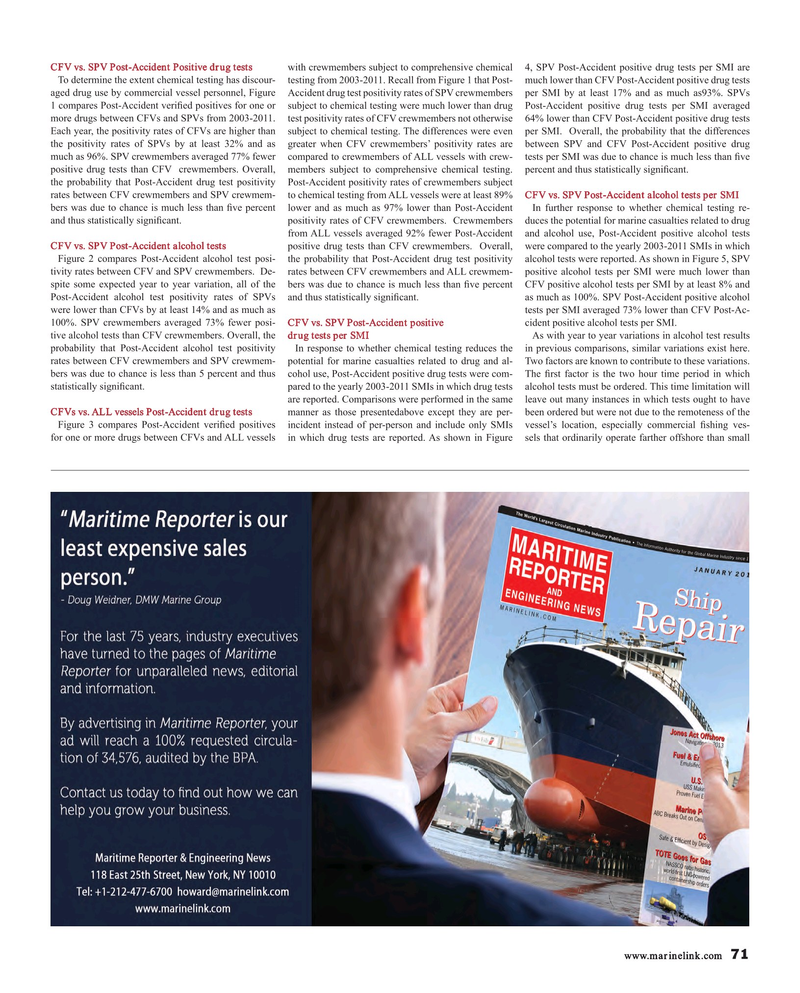
Page 71: of Maritime Reporter Magazine (March 2018)
Annual World Yearbook
Read this page in Pdf, Flash or Html5 edition of March 2018 Maritime Reporter Magazine
CFV vs. SPV Post-Accident Positive drug tests with crewmembers subject to comprehensive chemical 4, SPV Post-Accident positive drug tests per SMI are
To determine the extent chemical testing has discour- testing from 2003-2011. Recall from Figure 1 that Post- much lower than CFV Post-Accident positive drug tests aged drug use by commercial vessel personnel, Figure Accident drug test positivity rates of SPV crewmembers per SMI by at least 17% and as much as93%. SPVs 1 compares Post-Accident veri? ed positives for one or subject to chemical testing were much lower than drug Post-Accident positive drug tests per SMI averaged more drugs between CFVs and SPVs from 2003-2011. test positivity rates of CFV crewmembers not otherwise 64% lower than CFV Post-Accident positive drug tests
Each year, the positivity rates of CFVs are higher than subject to chemical testing. The differences were even per SMI. Overall, the probability that the differences the positivity rates of SPVs by at least 32% and as greater when CFV crewmembers’ positivity rates are between SPV and CFV Post-Accident positive drug much as 96%. SPV crewmembers averaged 77% fewer compared to crewmembers of ALL vessels with crew- tests per SMI was due to chance is much less than ? ve positive drug tests than CFV crewmembers. Overall, members subject to comprehensive chemical testing. percent and thus statistically signi? cant. the probability that Post-Accident drug test positivity Post-Accident positivity rates of crewmembers subject rates between CFV crewmembers and SPV crewmem- to chemical testing from ALL vessels were at least 89% CFV vs. SPV Post-Accident alcohol tests per SMI bers was due to chance is much less than ? ve percent lower and as much as 97% lower than Post-Accident In further response to whether chemical testing re- and thus statistically signi? cant. positivity rates of CFV crewmembers. Crewmembers duces the potential for marine casualties related to drug from ALL vessels averaged 92% fewer Post-Accident and alcohol use, Post-Accident positive alcohol tests
CFV vs. SPV Post-Accident alcohol tests positive drug tests than CFV crewmembers. Overall, were compared to the yearly 2003-2011 SMIs in which
Figure 2 compares Post-Accident alcohol test posi- the probability that Post-Accident drug test positivity alcohol tests were reported. As shown in Figure 5, SPV tivity rates between CFV and SPV crewmembers. De- rates between CFV crewmembers and ALL crewmem- positive alcohol tests per SMI were much lower than spite some expected year to year variation, all of the bers was due to chance is much less than ? ve percent CFV positive alcohol tests per SMI by at least 8% and
Post-Accident alcohol test positivity rates of SPVs and thus statistically signi? cant. as much as 100%. SPV Post-Accident positive alcohol were lower than CFVs by at least 14% and as much as tests per SMI averaged 73% lower than CFV Post-Ac- 100%. SPV crewmembers averaged 73% fewer posi- CFV vs. SPV Post-Accident positive cident positive alcohol tests per SMI. tive alcohol tests than CFV crewmembers. Overall, the drug tests per SMI As with year to year variations in alcohol test results probability that Post-Accident alcohol test positivity In response to whether chemical testing reduces the in previous comparisons, similar variations exist here. rates between CFV crewmembers and SPV crewmem- potential for marine casualties related to drug and al- Two factors are known to contribute to these variations. bers was due to chance is less than 5 percent and thus cohol use, Post-Accident positive drug tests were com- The ? rst factor is the two hour time period in which statistically signi? cant. pared to the yearly 2003-2011 SMIs in which drug tests alcohol tests must be ordered. This time limitation will are reported. Comparisons were performed in the same leave out many instances in which tests ought to have
CFVs vs. ALL vessels Post-Accident drug tests manner as those presentedabove except they are per- been ordered but were not due to the remoteness of the
Figure 3 compares Post-Accident veri? ed positives incident instead of per-person and include only SMIs vessel’s location, especially commercial ? shing ves- for one or more drugs between CFVs and ALL vessels in which drug tests are reported. As shown in Figure sels that ordinarily operate farther offshore than small www.marinelink.com 71
MR #3 (66-73).indd 71 MR #3 (66-73).indd 71 3/7/2018 9:11:21 AM3/7/2018 9:11:21 AM

 70
70

 72
72
